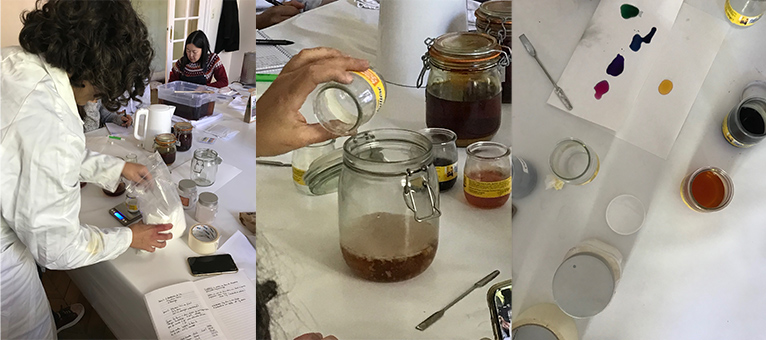4. Biochromes¶
WEEK 4:
This is the first time I have had the great experience of working with biomaterials to create colors. To enhance the experience we have decided to do this task collectively. Together we were able to create 6 dyes for 8 different textile materials. Including some tests of color modification through iron. One of the team created a dye with bacterial pigment, and we were able to learn about the combinations to produce pigments and inks.

DYES¶
1-Selecting plants to be used as dyes

2-Weigh the fabrics to define the amount of aluminum in the Mordant process, and the amount of plants to create the baths.
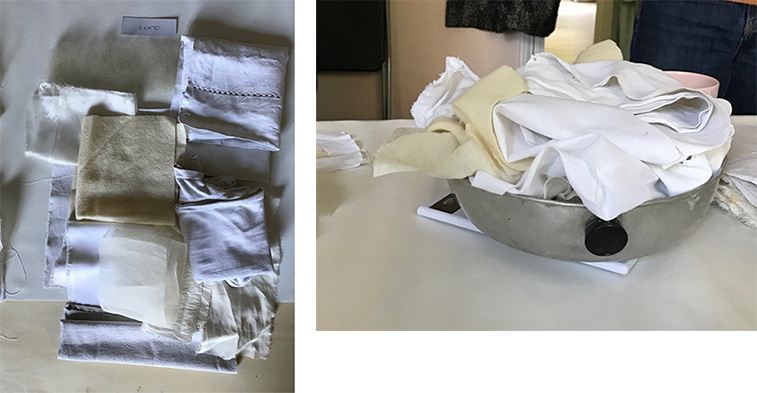
3-MORDANT Process
The mordant solution should be placed at a temperature between 40 and 60 degrees. Then the fabrics are immersed and it should cook for approximately 40 minutes.
The 3 mordanting bath we did :
Mordant 1: 452g fibers | 90,4g alum + 45,2g sodium carbonate + 1L vinegar. Were used for Onion and Carrot plants.
Mordant 2: 550g fibers | 110g alum. Were used for Madder and Annatto plants.
Mordant 3: 507g fibers | 100g alum + 50g lime (half of the alum weight in lime) + 0,5L vinegar. Were used for Nettle and Avocado plants.
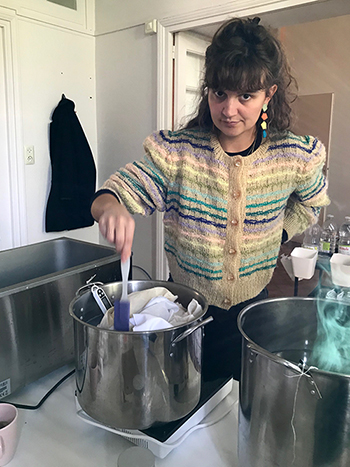
4-DYEING baths
To create the dyes in principle should be even, for 100 gr of fabric 100 gr of organic matter. But it can be readjusted depending on the selected plants. If it is very strong, such as onion peel, the amount should be decreased or if it is very soft, the amount can be increased, as in the case of nettle.
2-The weight of the fabrics to obtain the amount of ingredients to be used in each dye bath.
Quantities of dyeing stuff according to fiber weight
Dry dying stuff : 100% of fiber weight
Wet dying stuff : More of fiber weight
Dying extract : 10% of fiber weight
Weight of different dying stuff for our baths :
Leaf carrot : 75g wet and 125g dry for 248gr of fabric.
Onion peel : 44g dry (because colour is very intense) for 194gr of fabric.
Madder : 28,3 g (extract) for 283g of fabric.
Annatto : 100gr dry (total weight of what we have) for 267gr of fabric.
Nettle : 350 g for 220 gr of fabric.
Avocado : 210g dry for 210gr of fabric.
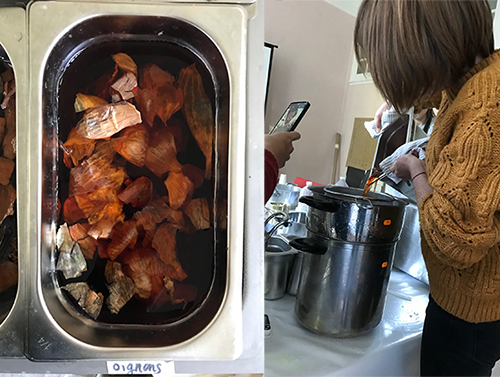
Except the madder, the different dyeing stuff was immersed in hot water to make the decoction. The baths remained overnight in hot water to activate the color of the dye. The next day they were filtered so that no residues of the plants remained.

5-DYEING process
All the textiles after the mordanting process were rinsed with water and the dyeing process was done while still wet. When the temperature of the dye reaches 60 degrees, the 45 minutes that will last this process of decoction of the textile inside the dye begin to count.

Drying
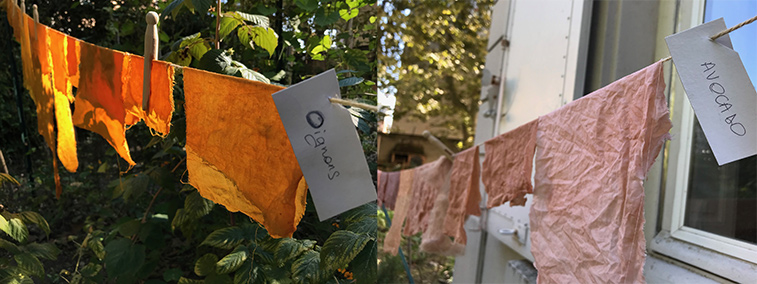
Classification and registration of the results
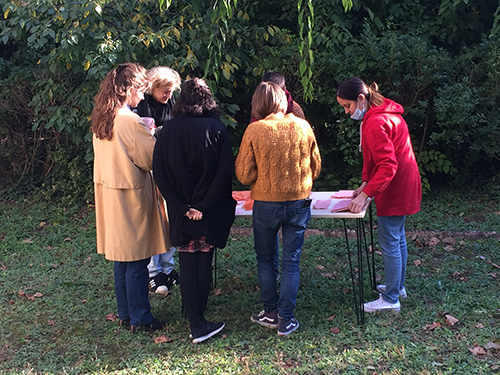
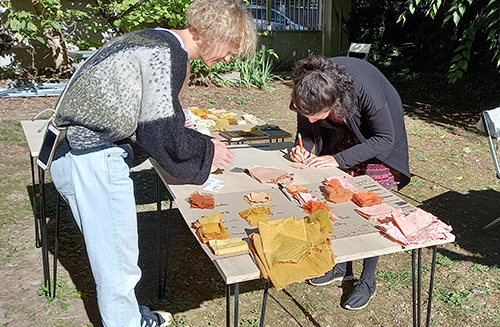
Shades of colors that obtained
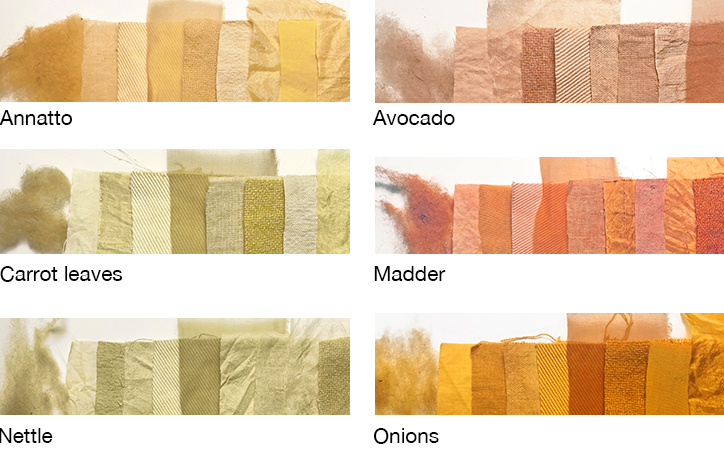
Modifying colors
A way to modify the obtained colours is to modify them with Iron.
Recipe for a solution with 100% Iron
200g Iron (sulfate) 2L Vinegar 100g Sodium carbonate
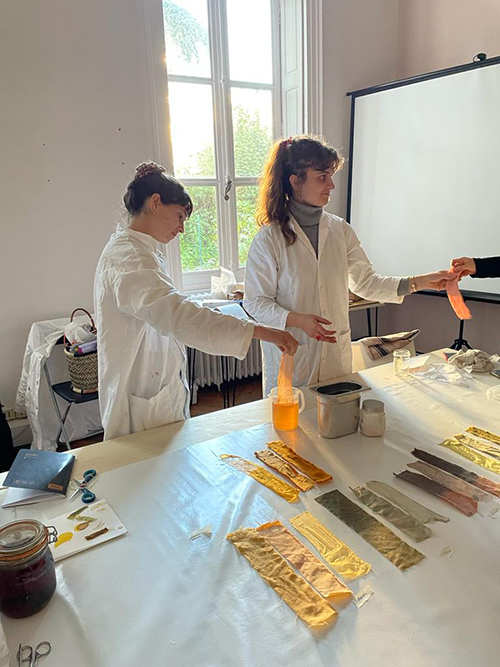
PIGMENTS and INKS¶
Pigments¶
We made pigments from the red onion dye bath. Pigments can be used for inks, biomaterials, oil paint… Pigments dissolve very well in oil but not in water.
Recipe to make pigment from a dye bath
200mL of the dye bath 20g of alum
5g of sodium carbonate
Put 200mL of dye bath in a jar Dissolve 20g of alum in hot water in a pot Dissolve 5g of sodium carbonate in hot water in an other pot Put the alum solution in the jar (with the dye bath) Add slowly the sodium carbonate in the jar, be careful because it may go up Let the jar open for 2 hours
The solution will separate into 2 phases, one liquid and one solid. After 2 hours, it must be filtered (we used a coffee filter), then dried and grinded. We didn’t have time enough to grind it because it wasn’t dry enough.
Inks¶
Diane showed us how to make ink from red cabbage. She immersed it and boiled it in hot water (time?). Then, we took some of the liquid and put it on paper : it gives a purple. With alum, iron, vinegar or sodium carbonate we obtained colour changes.
There is another way to make ink with 90% ethanol that we didn’ tried. For instance it works very well with turmeric, we have an example of this ink in Oullins.
